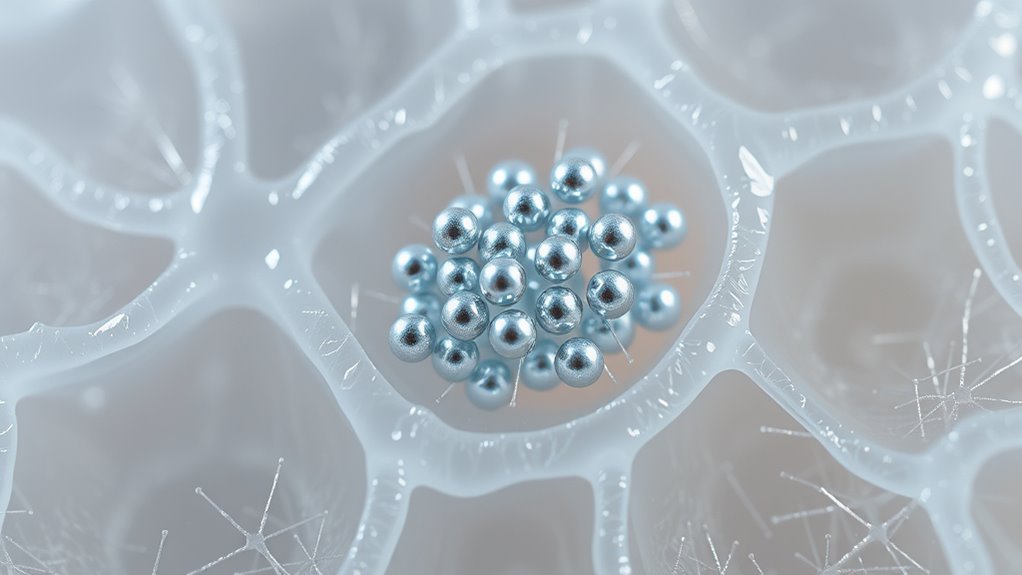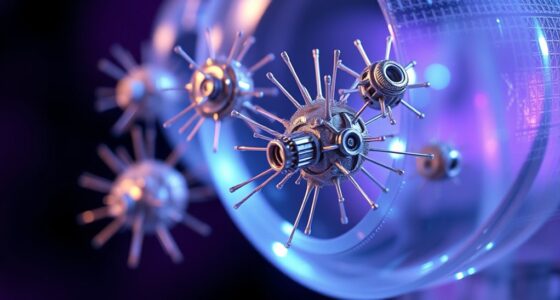Smart nano-implants are tiny, wireless devices designed to monitor your health in real time and deliver targeted treatments directly inside your body. They operate without bulky batteries by drawing energy from external sources through advanced wireless power tech, ensuring safety and convenience. Made from biocompatible materials, they minimize immune reactions while tracking essential signs or repairing tissues at the cellular level. By integrating sensors and communication modules into small packages, these implants could transform personalized healthcare—continue exploring to learn more about their potential.
Key Takeaways
- Enable real-time internal health monitoring and early disease detection through tiny, integrated sensors.
- Use wireless power transfer methods to operate without bulky batteries, enhancing miniaturization.
- Made from biocompatible materials to prevent immune responses and ensure safe long-term implantation.
- Incorporate sensors, communication modules, and energy harvesters within compact, integrated nano-devices.
- Support autonomous, minimally invasive treatments, transforming personalized medicine and healthcare delivery.

Have you ever wondered how tiny devices can revolutionize medicine and technology? The answer lies in smart nano-implants—microscopic devices designed to operate inside your body, providing real-time health monitoring, targeted drug delivery, and even repairing tissues at the cellular level. These innovations are possible thanks to advances in wireless power and biocompatibility considerations. Wireless power allows nano-implants to function without bulky batteries or invasive procedures to recharge or replace power sources. Instead, they harness electromagnetic fields, radio waves, or magnetic resonance to draw energy from external devices. This method keeps implants lightweight and unobtrusive, enabling continuous operation over extended periods. It also minimizes the risk of infection and reduces the need for repeated surgeries, making the entire process safer and more efficient. When designing these tiny devices, biocompatibility considerations come into play. You need to ensure that the materials used in manufacturing won’t provoke adverse immune responses or tissue damage. Researchers often turn to biocompatible materials like certain polymers, ceramics, or coated metals that can safely coexist within the human body. This careful selection helps prevent rejection and ensures the nano-implants can perform their functions reliably over time. Achieving biocompatibility is critical because it directly impacts the longevity and safety of these devices. If a nano-implant isn’t compatible with body tissues, it could cause inflammation, fibrosis, or other complications, defeating its purpose. To address this, scientists are also exploring surface modifications and coatings that promote tissue integration and reduce immune responses. Beyond power and material considerations, the miniaturization of components presents unique challenges. You need sensors, communication modules, and energy harvesters that are all tiny yet highly efficient. Advances in nanotechnology enable the integration of these elements into a single, compact device that can communicate wirelessly with external systems. This wireless communication is essential for transmitting health data and receiving updates or commands. Additionally, incorporating energy harvesting techniques can further extend the lifespan of nano-implants without external power sources. The synergy of wireless power and biocompatibility considerations makes smart nano-implants feasible and safe. As you look ahead, these devices could become commonplace in personalized medicine, enabling continuous health monitoring, early disease detection, and even autonomous treatment. The future of nano-implants is promising, driven by innovations in wireless power transfer and biocompatible materials that ensure safety, durability, and seamless integration within the human body. Ultimately, these tiny marvels could transform how we approach healthcare, making treatments less invasive and more effective than ever before.
Frequently Asked Questions
What Materials Are Used to Manufacture Nano-Implants?
You use materials like biocompatible metals, polymers, and ceramics to manufacture nano-implants. During manufacturing techniques, you perform biocompatibility testing to guarantee safety and effectiveness. These materials are chosen for their ability to integrate seamlessly with body tissues and resist corrosion. You focus on precise, scalable production methods to create reliable, functional nano-implants that meet medical standards and minimize adverse reactions in patients.
How Long Do Nano-Implants Typically Last Inside the Body?
You might wonder how long nano-implants last inside your body. Their lifespan varies, influenced by implant durability and environmental factors. Typically, they can function from months to several years, depending on design and materials used. Factors like corrosion, biological interactions, and power sources play roles. If maintained well and designed with durability in mind, nano-implants can serve effectively for extended periods, providing ongoing benefits without frequent replacements.
Are Nano-Implants Customizable for Individual Patient Needs?
Yes, nano-implants are customizable for individual patient needs. They offer personalized treatment by adapting their functions to your specific health requirements. Device adaptability allows you to benefit from targeted therapies that can be tailored during manufacturing or even adjusted later. This guarantees peak performance and better health outcomes, making nano-implants a flexible and precise solution for your medical care.
What Are the Risks of Rejection or Infection?
Rejection risks rise when your immune response reacts aggressively to nano-implants, causing complications. Infection risks multiply with biofilm formation, where bacteria build bulky barriers on implant surfaces, making treatments tougher. You could experience swelling, redness, or discomfort if your immune system fights the implant or if bacteria take hold. Vigilant monitoring and advanced coatings help minimize these risks, but staying aware is key to maintaining implant health and avoiding adverse reactions.
How Do Nano-Implants Communicate With External Devices?
You can think of nano-implants communicating with external devices through wireless transmission. They use signal modulation to send data, which allows precise control and monitoring. The implants encode information into electromagnetic signals, then transmit it wirelessly to external receivers like smartphones or specialized equipment. This process is secure and efficient, enabling real-time data exchange while minimizing invasiveness and maintaining the implant’s small size.
Conclusion
As you stand on the brink of this tiny revolution, these smart nano-implants become your silent guardians, weaving through your body like delicate threads of innovation. They hold the power to reveal a future where health and technology dance in perfect harmony, whispering promises of healing and discovery. Embrace this microscopic symphony, for within these tiny marvels lies the potential to transform your world, turning science fiction into your everyday reality—small in size, mighty in impact.









